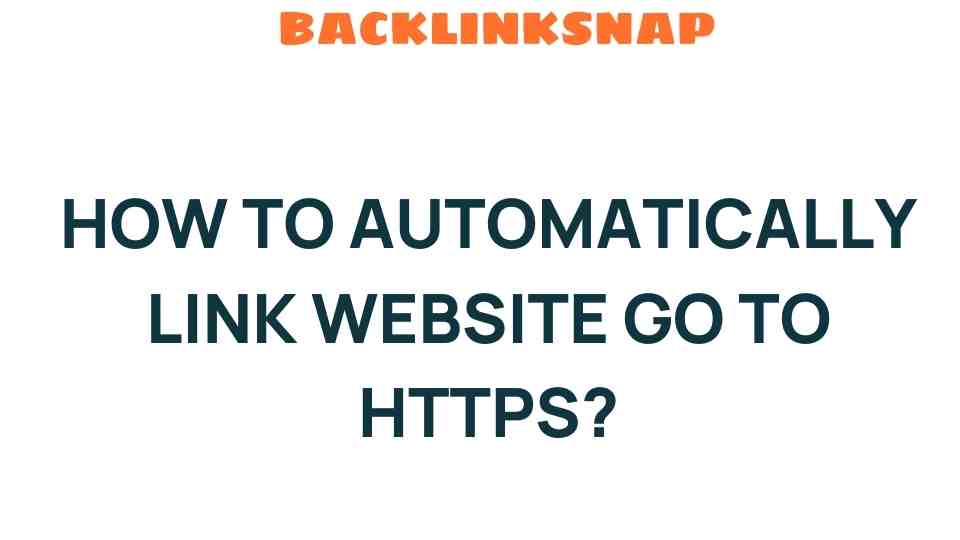Seamlessly Transition: How to Automatically Link Your Website to HTTPS
In today’s digital landscape, ensuring your website is secure is no longer optional; it’s essential. Transitioning your site from HTTP to HTTPS is a significant step in enhancing your website security and fostering user trust. This article will guide you through the process of automatically linking your website to HTTPS while highlighting the importance of an SSL certificate, the SEO benefits involved, and how to manage this site migration smoothly.
The Importance of HTTPS for Website Security
HTTPS, which stands for HyperText Transfer Protocol Secure, is the secure version of HTTP. It uses SSL (Secure Sockets Layer) or TLS (Transport Layer Security) protocols to encrypt the data exchanged between a user’s browser and your web server. This encryption is critical for protecting sensitive information—such as personal details and payment data—from cyber threats.
With cyberattacks on the rise, website security has become paramount. By switching to HTTPS, you not only safeguard your users’ data but also improve your site’s credibility. Users are increasingly aware of digital safety, and a secure site reassures them that their interactions are safe, significantly enhancing user trust.
How SSL Certificates Work
An SSL certificate is a digital certificate that authenticates your website’s identity and enables an encrypted connection. Here’s how it works:
- Authentication: The SSL certificate verifies that the website is owned by a legitimate entity.
- Encryption: It creates a secure connection between the user’s browser and your web server, ensuring that data transferred is unreadable to outsiders.
- Data Integrity: SSL certificates help prevent data from being corrupted during transfer.
Obtaining an SSL certificate is relatively straightforward. You can acquire one from various certificate authorities, such as Let’s Encrypt, Comodo, or DigiCert. Many web hosting services also offer SSL certificates included in their packages, making it easier for you to ensure your site is secure.
SEO Benefits of Switching to HTTPS
One of the lesser-known advantages of using HTTPS is its positive impact on SEO. Google has confirmed that sites using HTTPS receive a ranking boost compared to their HTTP counterparts. This means that transitioning to HTTPS can help improve your search engine visibility, driving more traffic to your site.
Here are some specific SEO benefits of switching to HTTPS:
- Enhanced rankings: HTTPS is a ranking factor in Google’s algorithm.
- Increased click-through rates: Users are more likely to click on HTTPS links over HTTP links, as they perceive them to be safer.
- Better engagement: A secure site fosters user trust, potentially increasing the time spent on your site and reducing bounce rates.
Steps for Seamlessly Migrating to HTTPS
Transitioning to HTTPS may seem daunting, but with a structured approach, it can be a seamless process. Here’s how you can do it:
- Obtain an SSL certificate: As mentioned earlier, acquire an SSL certificate from a trusted provider or your web host.
- Install the SSL certificate: Follow your hosting provider’s instructions to install the certificate on your server.
- Update your website content: Change all internal links to use HTTPS and ensure that any resources (like images, scripts, and stylesheets) are also loaded over HTTPS.
- 301 Redirects: Set up 301 redirects from your old HTTP pages to the new HTTPS pages to ensure users and search engines are directed to the secure version.
- Update your sitemap: Update your XML sitemap to reflect the new HTTPS URLs and submit it to search engines.
- Monitor your site: Use tools like Google Search Console to monitor your site’s performance and address any issues that arise after migration.
Potential Pitfalls to Avoid
While transitioning to HTTPS is largely beneficial, there are potential pitfalls to be aware of. Here are some common issues to watch out for:
- Mixed Content: This occurs when a secure page loads resources over HTTP. Ensure all resources are served over HTTPS to avoid security warnings.
- Broken Links: Check for any broken internal links and fix them promptly to maintain user experience and SEO health.
- Incomplete Migration: Ensure that every single page is migrated to HTTPS to avoid losing traffic and search rankings.
FAQs
1. What is the difference between HTTP and HTTPS?
HTTP is an unsecured protocol, while HTTPS is a secure version that encrypts data exchanged between the server and the browser.
2. Do I need an SSL certificate for my website?
Yes, if you handle sensitive information or want to build trust with your users, an SSL certificate is essential.
3. Will switching to HTTPS affect my SEO?
Switching to HTTPS can positively affect your SEO, as search engines like Google give preference to secure sites.
4. How can I check if my site is using HTTPS?
Simply look at the URL in your browser’s address bar. If it starts with “https://”, your site is secure.
5. What should I do if I encounter mixed content issues?
You should ensure all resources are loaded over HTTPS. Update any HTTP links in your code or resources.
6. How long does it take to migrate to HTTPS?
The time required can vary, but a straightforward migration can often be completed within a few hours, while more complex sites may take longer.
Conclusion
Transitioning to HTTPS is not just a technical upgrade; it’s a commitment to digital safety and user trust. By adopting HTTPS, you enhance your website security, unlock valuable SEO benefits, and provide a safer online experience for your visitors. With the right preparation and execution, your migration can be seamless and successful. So, take the leap—secure your website today and reap the rewards for years to come.
For further reading on website security best practices, you can check out this resource. And for more insights into enhancing your site’s performance, visit our web development guide.
This article is in the category SEO Optimization and created by BacklinkSnap Team




